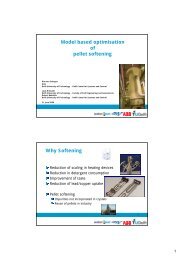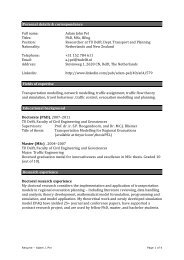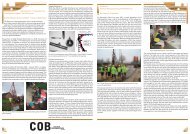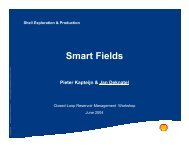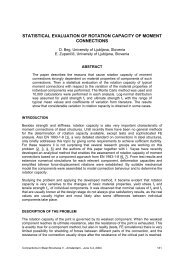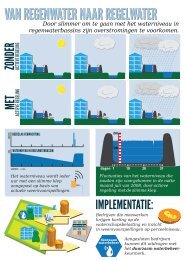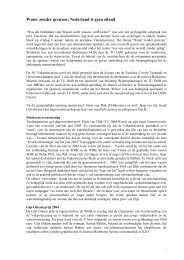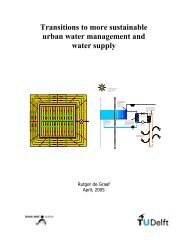Pedestrian route-choice and activity scheduling theory and models
Pedestrian route-choice and activity scheduling theory and models
Pedestrian route-choice and activity scheduling theory and models
Create successful ePaper yourself
Turn your PDF publications into a flip-book with our unique Google optimized e-Paper software.
172 S.P. Hoogendoorn, P.H.L. Bovy / Transportation Research Part B 38 (2004) 169–190<br />
individuals. Nevertheless, the continuous <strong>theory</strong> is easily extended to include for instance taste<br />
variation.<br />
4.1. <strong>Pedestrian</strong> behavioral levels<br />
In out approach we distinguish <strong>choice</strong>s at the following three levels:<br />
1. Departure time <strong>choice</strong>, <strong>and</strong> <strong>activity</strong> pattern <strong>choice</strong> (strategic level);<br />
2. Activity <strong>scheduling</strong>, <strong>activity</strong> area <strong>choice</strong>, <strong>and</strong> <strong>route</strong>-<strong>choice</strong> to reach <strong>activity</strong> areas (tactical level);<br />
3. Walking behavior (operational level).<br />
In this hierarchy, expected utilities at lower levels influence <strong>choice</strong>s at higher levels. Choices at<br />
higher levels condition <strong>choice</strong> sets at lower levels. This article focuses on pedestrian behavior at<br />
the tactical level. The events <strong>and</strong> decisions causing the pedestrian to arrive at the walking facility<br />
are not considered; pedestrian arrival patterns, distinguishing groups of pedestrians having similar<br />
characteristics (<strong>activity</strong> sets, travel purpose, demographic characteristics, etc.) are assumed known<br />
a priori. With respect to the operational level, it is hypothesized that pedestrians adhere to their<br />
planned <strong>route</strong> (determined at the tactical level) as much as possible. In addition, walking is affected<br />
by interactions with other pedestrians or obstacles. For details, we refer to (Hoogendoorn,<br />
2001).<br />
The tactical level behavior is influenced by both external factors (e.g. presence of obstacles,<br />
stimulation of the environment), <strong>and</strong> internal (or personal) factors (e.g. time–pressure, attitudes of<br />
the pedestrian). Together with the expected traffic conditions (congestion, average speeds), the<br />
decisions at the tactical level serve as input for pedestrianÕs walking behavior. In turn, the traffic<br />
conditions resulting from the pedestrian traffic dem<strong>and</strong>s <strong>and</strong> the collective walking behavior will<br />
affect the expected traffic conditions <strong>and</strong> thus the behavior at the tactical level.<br />
4.2. Tactical level decision variables<br />
Before we present the problem formulation, let us introduce the key decision variables for the<br />
pedestrian behavior at the tactical level<br />
1. The <strong>activity</strong> schedule S ¼fig, which is an ordered set describing which activities i 2 R are performed<br />
<strong>and</strong> in which order.<br />
2. The velocity trajectory vðÞ yielding the <strong>route</strong> xðÞ through the facility.<br />
3. The <strong>activity</strong> times T i at which activities i 2 S are performed, such that xðT i Þ2A ij for some j,<br />
where A ij denote the <strong>activity</strong> areas where <strong>activity</strong> i can be performed.<br />
A pedestrian arriving at the walking facility X R 2 aims to perform (a type of) activities from<br />
the subjective <strong>activity</strong> <strong>choice</strong> set R, which consists of possible activities to perform in the facility,<br />
e.g. ‘‘buy a newspaper’’, ‘‘buy a train ticket’’, ‘‘wait at the train platform’’, or ‘‘access the train’’.<br />
The activities are generic, <strong>and</strong> reflect the purposes of the pedestrians in the facility.<br />
The pedestrian chooses activities from the subjective <strong>activity</strong> <strong>choice</strong> set R, yielding the <strong>activity</strong><br />
schedule S ¼fig. S describes which activities from R are performed <strong>and</strong> in which order. The



